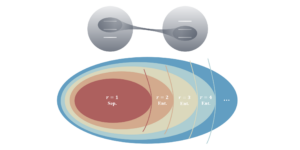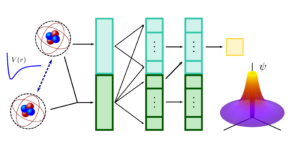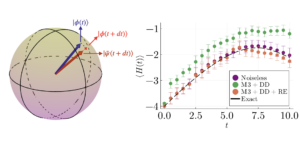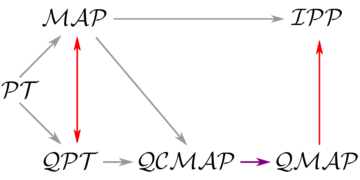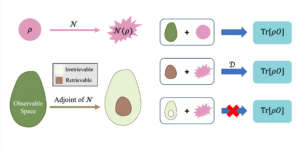DEVCOM Army Research Laboratory, 2800 Powder Mill Road, Adelphi, MD 20783, USA
Find this paper interesting or want to discuss? Scite or leave a comment on SciRate.
Abstract
We develop a framework of “semi-automatic differentiation” that combines existing gradient-based methods of quantum optimal control with automatic differentiation. The approach allows to optimize practically any computable functional and is implemented in two open source Julia packages, $tt{GRAPE.jl}$ and $tt{Krotov.jl}$, part of the $tt{QuantumControl.jl}$ framework. Our method is based on formally rewriting the optimization functional in terms of propagated states, overlaps with target states, or quantum gates. An analytical application of the chain rule then allows to separate the time propagation and the evaluation of the functional when calculating the gradient. The former can be evaluated with great efficiency via a modified GRAPE scheme. The latter is evaluated with automatic differentiation, but with a profoundly reduced complexity compared to the time propagation. Thus, our approach eliminates the prohibitive memory and runtime overhead normally associated with automatic differentiation and facilitates further advancement in quantum control by enabling the direct optimization of non-analytic functionals for quantum information and quantum metrology, especially in open quantum systems. We illustrate and benchmark the use of semi-automatic differentiation for the optimization of perfectly entangling quantum gates on superconducting qubits coupled via a shared transmission line. This includes the first direct optimization of the non-analytic gate concurrence.
Featured image: Numerical scheme for GRAPE with semi-automatic differentiation
Popular summary
► BibTeX data
► References
[1] Constantin Brif, Raj Chakrabarti, and Herschel Rabitz. “Control of quantum phenomena: past, present and future”. New J. Phys. 12, 075008 (2010).
https://doi.org/10.1088/1367-2630/12/7/075008
[2] Moshe Shapiro and Paul Brumer. “Quantum control of molecular processes”. Wiley & Sons. (2012). Second edition.
https://doi.org/10.1002/9783527639700
[3] Christiane P. Koch. “Controlling open quantum systems: tools, achievements, and limitations”. J. Phys.: Condens. Matter 28, 213001 (2016).
https://doi.org/10.1088/0953-8984/28/21/213001
[4] Ignacio R. Sola, Bo Y. Chang, Svetlana A. Malinovskaya, and Vladimir S. Malinovsky. “Quantum control in multilevel systems”. In Ennio Arimondo, Louis F. DiMauro, and Susanne F. Yelin, editors, Advances In Atomic, Molecular, and Optical Physics. Volume 67, chapter 3, pages 151–256. Academic Press (2018).
https://doi.org/10.1016/bs.aamop.2018.02.003
[5] Oleg V. Morzhin and Alexander N. Pechen. “Krotov method for optimal control of closed quantum systems”. Russ. Math. Surv. 74, 851 (2019).
https://doi.org/10.1070/rm9835
[6] Frank K. Wilhelm, Susanna Kirchhoff, Shai Machnes, Nicolas Wittler, and Dominique Sugny. “An introduction into optimal control for quantum technologies” (2020). arXiv:2003.10132.
arXiv:2003.10132
[7] Christiane P. Koch, Ugo Boscain, Tommaso Calarco, Gunther Dirr, Stefan Filipp, Steffen J. Glaser, Ronnie Kosloff, Simone Montangero, Thomas Schulte-Herbrüggen, Dominique Sugny, and Frank K. Wilhelm. “Quantum optimal control in quantum technologies. strategic report on current status, visions and goals for research in Europe”. EPJ Quantum Technol. 9, 19 (2022).
https://doi.org/10.1140/epjqt/s40507-022-00138-x
[8] Michael Nielsen and Isaac L. Chuang. “Quantum computation and quantum information”. Cambridge University Press. (2000).
https://doi.org/10.1017/CBO9780511976667
[9] Iulia M. Georgescu, Sahel Ashhab, and Franco Nori. “Quantum simulation”. Rev. Mod. Phys. 86, 153 (2014).
https://doi.org/10.1103/RevModPhys.86.153
[10] Christian L. Degen, Friedemann Reinhard, and Paola Cappellaro. “Quantum sensing”. Rev. Mod. Phys. 89, 035002 (2017).
https://doi.org/10.1103/RevModPhys.89.035002
[11] Ugo Boscain, Mario Sigalotti, and Dominique Sugny. “Introduction to the Pontryagin maximum principle for quantum optimal control”. PRX Quantum 2, 030203 (2021).
https://doi.org/10.1103/prxquantum.2.030203
[12] Navin Khaneja, Timo Reiss, Cindie Kehlet, Thomas Schulte-Herbrüggen, and Steffen J. Glaser. “Optimal control of coupled spin dynamics: design of NMR pulse sequences by gradient ascent algorithms”. J. Magnet. Res. 172, 296 (2005).
https://doi.org/10.1016/j.jmr.2004.11.004
[13] Pierre de Fouquières, Sophie G. Schirmer, Steffen J. Glaser, and Ilya Kuprov. “Second order gradient ascent pulse engineering”. J. Magnet. Res. 212, 412 (2011).
https://doi.org/10.1016/j.jmr.2011.07.023
[14] Vadim F. Krotov and N. N. Fel’dman. “An iterative method for solving optimal-control problems”. Engrg. Cybernetics 21, 123 (1983).
[15] Vadim F. Krotov. “A technique of global bounds in optimal control theory”. Control Cybern. 17, 115 (1988).
[16] Vadim F. Krotov. “Global methods in optimal control”. Dekker. New York, NY, USA (1996).
[17] József Somlói, Vladimir A. Kazakov, and David J. Tannor. “Controlled dissociation of I$_2$ via optical transitions between the X and B electronic states”. Chem. Phys. 172, 85 (1993).
https://doi.org/10.1016/0301-0104(93)80108-L
[18] Allon Bartana, Ronnie Kosloff, and David J. Tannor. “Laser cooling of internal degrees of freedom. II”. J. Chem. Phys. 106, 1435 (1997).
https://doi.org/10.1063/1.473973
[19] José P. Palao and Ronnie Kosloff. “Optimal control theory for unitary transformations”. Phys. Rev. A 68, 062308 (2003).
https://doi.org/10.1103/PhysRevA.68.062308
[20] Daniel M. Reich, Mamadou Ndong, and Christiane P. Koch. “Monotonically convergent optimization in quantum control using Krotov’s method”. J. Chem. Phys. 136, 104103 (2012).
https://doi.org/10.1063/1.3691827
[21] Amir Rashidinejad, Yihan Li, and Andrew M. Weiner. “Recent advances in programmable photonic-assisted ultrabroadband radio-frequency arbitrary waveform generation”. IEEE J. Quantum Electron. 52, 1 (2016).
https://doi.org/10.1109/jqe.2015.2506987
[22] Andrew M. Weiner. “Femtosecond pulse shaping using spatial light modulators”. Rev. Sci. Instr. 71, 1929 (2000).
https://doi.org/10.1063/1.1150614
[23] J. Robert Johansson, Paul D. Nation, and Franco Nori. “QuTiP 2: A Python framework for the dynamics of open quantum systems”. Comput. Phys. Commun. 184, 1234 (2013).
https://doi.org/10.1016/j.cpc.2012.11.019
[24] Shai Machnes, Uwe Sander, Steffen J. Glaser, Pierre de Fouquières, Audrūnas Gruslys, Sophie G. Schirmer, and Thomas Schulte-Herbrüggen. “Comparing, optimizing, and benchmarking quantum-control algorithms in a unifying programming framework”. Phys. Rev. A 84, 022305 (2011).
https://doi.org/10.1103/PhysRevA.84.022305
[25] Hannah J. Hogben, Matthew Krzystyniak, Gareth T. P. Charnock, Peter J. Hore, and Ilya Kuprov. “Spinach – a software library for simulation of spin dynamics in large spin systems”. J. Magnet. Res. 208, 179 (2011).
https://doi.org/10.1016/j.jmr.2010.11.008
[26] Zdeněk Tošner, Thomas Vosegaard, Cindie Kehlet, Navin Khaneja, Steffen J. Glaser, and Niels Chr. Nielsen. “Optimal control in NMR spectroscopy: Numerical implementation in SIMPSON”. J. Magnet. Res. 197, 120 (2009).
https://doi.org/10.1016/j.jmr.2008.11.020
[27] Michael H. Goerz, Daniel Basilewitsch, Fernando Gago-Encinas, Matthias G. Krauss, Karl P. Horn, Daniel M. Reich, and Christiane P. Koch. “Krotov: A Python implementation of Krotov’s method for quantum optimal control”. SciPost Phys. 7, 080 (2019).
https://doi.org/10.21468/scipostphys.7.6.080
[28] Samuel L. Braunstein and Carlton M. Caves. “Statistical distance and the geometry of quantum states”. Phys. Rev. Lett. 72, 3439 (1994).
https://doi.org/10.1103/physrevlett.72.3439
[29] Luca Pezzé and Augusto Smerzi. “Entanglement, nonlinear dynamics, and the Heisenberg limit”. Phys. Rev. Lett. 102, 100401 (2009).
https://doi.org/10.1103/physrevlett.102.100401
[30] Jian Ma, Xiaoguang Wang, Changpu P. Sun, and Franco Nori. “Quantum spin squeezing”. Phys. Rep. 509, 89 (2011).
https://doi.org/10.1016/j.physrep.2011.08.003
[31] Barbara Kraus and J. Ignacio Cirac. “Optimal creation of entanglement using a two-qubit gate”. Phys. Rev. A 63, 062309 (2001).
https://doi.org/10.1103/PhysRevA.63.062309
[32] Jun Zhang, Jiří Vala, Shankar Sastry, and K. Birgitta Whaley. “Geometric theory of nonlocal two-qubit operations”. Phys. Rev. A 67, 042313 (2003).
https://doi.org/10.1103/PhysRevA.67.042313
[33] Paul Watts, Maurice O’Connor, and Jiří Vala. “Metric structure of the space of two-qubit gates, perfect entanglers and quantum control”. Entropy 15, 1963 (2013).
https://doi.org/10.3390/e15061963
[34] Paul Watts, Jiří Vala, Matthias M. Müller, Tommaso Calarco, K. Birgitta Whaley, Daniel M. Reich, Michael H. Goerz, and Christiane P. Koch. “Optimizing for an arbitrary perfect entangler: I. Functionals”. Phys. Rev. A 91, 062306 (2015).
https://doi.org/10.1103/PhysRevA.91.062306
[35] Michael H. Goerz, Giulia Gualdi, Daniel M. Reich, Christiane P. Koch, Felix Motzoi, K. Birgitta Whaley, Jiří Vala, Matthias M. Müller, Simone Montangero, and Tommaso Calarco. “Optimizing for an arbitrary perfect entangler. II. Application”. Phys. Rev. A 91, 062307 (2015).
https://doi.org/10.1103/PhysRevA.91.062307
[36] Hamza Jirari. “Optimal control approach to dynamical suppression of decoherence of a qubit”. Europhys. Lett. 87, 40003 (2009).
https://doi.org/10.1209/0295-5075/87/40003
[37] Nelson Leung, Mohamed Abdelhafez, Jens Koch, and David I. Schuster. “Speedup for quantum optimal control from automatic differentiation based on graphics processing units”. Phys. Rev. A 95, 042318 (2017).
https://doi.org/10.1103/PhysRevA.95.042318
[38] Mohamed Abdelhafez, David I. Schuster, and Jens Koch. “Gradient-based optimal control of open quantum systems using quantum trajectories and automatic differentiation”. Phys. Rev. A 99, 052327 (2019).
https://doi.org/10.1103/PhysRevA.99.052327
[39] Mohamed Abdelhafez, Brian Baker, András Gyenis, Pranav Mundada, Andrew A. Houck, David I. Schuster, and Jens Koch. “Universal gates for protected superconducting qubits using optimal control”. Phys. Rev. A 101, 022321 (2020).
https://doi.org/10.1103/physreva.101.022321
[40] Frank Schäfer, Michal Kloc, Christoph Bruder, and Niels Lörch. “A differentiable programming method for quantum control”. Mach. Learn.: Sci. Technol. 1, 035009 (2020).
https://doi.org/10.1088/2632-2153/ab9802
[41] Nelson Leung and Contributors (2021). code: SchusterLab/quantum-optimal-control.
https://github.com/SchusterLab/quantum-optimal-control
[42] Daniel Weiss and Contributors (2021). code: SchusterLab/qoc.
https://github.com/SchusterLab/qoc
[43] Andreas Griewank and Andrea Walther. “Evaluating derivatives”. Society for Industrial and Applied Mathematics. Philadelphia (2008). Second edition.
https://doi.org/10.1137/1.9780898717761
[44] Charles C. Margossian. “A review of automatic differentiation and its efficient implementation”. WIREs Data Mining Knowl Discov. 9 (2019).
https://doi.org/10.1002/widm.1305
[45] Frank Schäfer, Pavel Sekatski, Martin Koppenhöfer, Christoph Bruder, and Michal Kloc. “Control of stochastic quantum dynamics by differentiable programming”. Mach. Learn.: Sci. Technol. 2, 035004 (2021).
https://doi.org/10.1088/2632-2153/abec22
[46] Thomas Propson, Brian E. Jackson, Jens Koch, Zachary Manchester, and David I. Schuster. “Robust quantum optimal control with trajectory optimization”. Phys. Rev. Applied 17, 014036 (2022).
https://doi.org/10.1103/physrevapplied.17.014036
[47] Michael H. Goerz and Kurt Jacobs. “Efficient optimization of state preparation in quantum networks using quantum trajectories”. Quantum Sci. Technol. 3, 045005 (2018).
https://doi.org/10.1088/2058-9565/aace16
[48] Nicolas Wittler, Federico Roy, Kevin Pack, Max Werninghaus, Anurag Saha Roy, Daniel J. Egger, Stefan Filipp, Frank K. Wilhelm, and Shai Machnes. “Integrated tool set for control, calibration, and characterization of quantum devices applied to superconducting qubits”. Phys. Rev. Applied 15, 034080 (2021).
https://doi.org/10.1103/physrevapplied.15.034080
[49] Harrison Ball, Michael J. Biercuk, Andre Carvalho, Jiayin Chen, Michael Hush, Leonardo A. De Castro, Li Li, Per J. Liebermann, Harry J. Slatyer, Claire Edmunds, Virginia Frey, Cornelius Hempel, and Alistair Milne. “Software tools for quantum control: Improving quantum computer performance through noise and error suppression” (2020). arXiv:2001.04060.
arXiv:2001.04060
[50] Asad Raza and Contributors (2022). code: qgrad/qgrad.
https://github.com/qgrad/qgrad
[51] Andreas Griewank. “Who invented the reverse mode of differentiation”. In Martin Grötschel, editor, Optimization Stories. Pages 389–400. Documenta Mathematica. 21st International Symposium on Mathematical Programming, Berlin (2012). url: www.zib.de/groetschel/publications/OptimizationStories.pdf.
https://www.zib.de/groetschel/publications/OptimizationStories.pdf
[52] David E. Rumelhart, Geoffrey E. Hinton, and Ronald J. Williams. “Learning representations by back-propagating errors”. Nature 323, 533 (1986).
https://doi.org/10.1038/323533a0
[53] Martin Abadi, Paul Barham, Jianmin Chen, Zhifeng Chen, Andy Davis, Jeffrey Dean, Matthieu Devin, Sanjay Ghemawat, Geoffrey Irving, Michael Isard, Manjunath Kudlur, Josh Levenberg, Rajat Monga, Sherry Moore, Derek G. Murray, Benoit Steiner, Paul Tucker, Vijay Vasudevan, Pete Warden, Martin Wicke, Yuan Yu, and Xiaoqiang Zheng. “Tensorflow: A system for large-scale machine learning”. In 12th USENIX Symposium on Operating Systems Design and Implementation (OSDI 16). Page 265. (2016). url: www.tensorflow.org/.
https://www.tensorflow.org/
[54] Adam Paszke, Sam Gross, Francisco Massa, Adam Lerer, James Bradbury, Gregory Chanan, Trevor Killeen, Zeming Lin, Natalia Gimelshein, Luca Antiga, Alban Desmaison, Andreas Köpf, Edward Yang, Zachary DeVito, Martin Raison, Alykhan Tejani, Sasank Chilamkurthy, Benoit Steiner, Lu Fang, Junjie Bai, and Soumith Chintala. “PyTorch: An imperative style, high-performance deep learning library”. In Hanna M. Wallach, Hugo Larochelle, Alina Beygelzimer, Florence d’Alché Buc, Edward A. Fox, and Roman Garnett, editors, Advances in Neural Information Processing Systems 32. Pages 8024–8035. Vancouver, BC, Canada (2019). Annual Conference on Neural Information Processing Systems 2019, NeurIPS 2019. url: http://papers.neurips.cc/paper/9015-pytorch-an-imperative-style-high-performance-deep-learning-library.pdf.
http://papers.neurips.cc/paper/9015-pytorch-an-imperative-style-high-performance-deep-learning-library.pdf
[55] Adam Paszke and Contributors (2022). code: pytorch/pytorch.
https://github.com/pytorch/pytorch
[56] Roy Frostig, Matthew Johnson, and Chris Leary. “Compiling machine learning programs via high-level tracing”. In SysML Conference. Stanford, CA (2018). url: mlsys.org/Conferences/2019/doc/2018/146.pdf.
https://mlsys.org/Conferences/2019/doc/2018/146.pdf
[57] James Bradbury, Roy Frostig, Peter Hawkins, Matthew James Johnson, Chris Leary, Dougal Maclaurin, George Necula, Adam Paszke, Jake VanderPlas, Skye Wanderman-Milne, and Qiao Zhang (2018). code: google/jax.
https://github.com/google/jax
[58] Michael Innes, Elliot Saba, Keno Fischer, Dhairya Gandhi, Marco Concetto Rudilosso, Neethu Mariya Joy, Tejan Karmali, Avik Pal, and Viral Shah. “Fashionable modelling with Flux” (2018). arXiv:1811.01457.
arXiv:1811.01457
[59] Michael Innes. “Flux: Elegant machine learning with Julia”. J. Open Source Softw. 3, 602 (2018).
https://doi.org/10.21105/joss.00602
[60] Michael Innes. “Don’t unroll adjoint: Differentiating SSA-form programs” (2018). arXiv:1810.07951.
arXiv:1810.07951
[61] Michael Innes and Contributors (2022). code: FluxML/Zygote.jl.
https://github.com/FluxML/Zygote.jl
[62] Hillel Tal-Ezer and Ronnie Kosloff. “An accurate and efficient scheme for propagating the time dependent Schrödinger equation”. J. Chem. Phys. 81, 3967 (1984).
https://doi.org/10.1063/1.448136
[63] Ronnie Kosloff. “Time-dependent quantum-mechanical methods for molecular dynamics”. J. Chem. Phys. 92, 2087 (1988).
https://doi.org/10.1021/j100319a003
[64] Michael Berman, Ronnie Kosloff, and Hillel Tal-Ezer. “Solution of the time-dependent liouville-von neumann equation: dissipative evolution”. J. Phys. A 25, 1283 (1992).
https://doi.org/10.1088/0305-4470/25/5/031
[65] Ronnie Kosloff. “Propagation methods for quantum molecular dynamics”. Annu. Rev. Phys. Chem. 45, 145 (1994).
https://doi.org/10.1146/annurev.pc.45.100194.001045
[66] Guy Ashkenazi, Ronnie Kosloff, Sanford Ruhman, and Hillel Tal-Ezer. “Newtonian propagation methods applied to the photodissociation dynamics of I$_3^{-}$”. J. Chem. Phys. 103, 10005–10014 (1995).
https://doi.org/10.1063/1.469904
[67] Jeff Bezanson, Alan Edelman, Stefan Karpinski, and Viral B. Shah. “Julia: A fresh approach to numerical computing”. SIAM Rev. 59, 65 (2017).
https://doi.org/10.1137/141000671
[68] “The Julia programming language”. url: julialang.org.
https://julialang.org
[69] Michael H. Goerz and Contributors (2022). code: JuliaQuantumControl/GRAPE.jl.
https://github.com/JuliaQuantumControl/GRAPE.jl
[70] Michael H. Goerz and Contributors (2022). code: JuliaQuantumControl/Krotov.jl.
https://github.com/JuliaQuantumControl/Krotov.jl
[71] Michael H. Goerz and Contributors (2022). code: JuliaQuantumControl/QuantumControl.jl.
https://github.com/JuliaQuantumControl/QuantumControl.jl
[72] Jens Koch, Terri M. Yu, Jay Gambetta, Andrew A. Houck, David I. Schuster, Johannes Majer, Alexandre Blais, Michel H. Devoret, Steven M. Girvin, and Robert J. Schoelkopf. “Charge-insensitive qubit design derived from the Cooper pair box”. Phys. Rev. A 76, 042319 (2007).
https://doi.org/10.1103/PhysRevA.76.042319
[73] Alexandre Blais, Jay Gambetta, A. Wallraff, D. I. Schuster, Steven M. Girvin, M. H. Devoret, and Robert J. Schoelkopf. “Quantum-information processing with circuit quantum electrodynamics”. Phys. Rev. A 75, 032329 (2007).
https://doi.org/10.1103/PhysRevA.75.032329
[74] Michael H. Goerz, Daniel M. Reich, and Christiane P. Koch. “Optimal control theory for a unitary operation under dissipative evolution” (2021). arXiv:1312.0111v2.
https://doi.org/10.1088/1367-2630/16/5/055012
arXiv:1312.0111v2
[75] The MathWorks. Natick, MA, USA. “Matlab optimization toolbox”. (2018).
[76] Pauli Virtanen, Ralf Gommers, Travis E. Oliphant, Matt Haberland, Tyler Reddy, David Cournapeau, Evgeni Burovski, Pearu Peterson, Warren Weckesser, Jonathan Bright, Stéfan J. van der Walt, Matthew Brett, Joshua Wilson, K. Jarrod Millman, Nikolay Mayorov, Andrew R. J. Nelson, Eric Jones, Robert Kern, Eric Larson, CJ Carey, İlhan Polat, Yu Feng, Eric W. Moore, Jake VanderPlas, Denis Laxalde, Josef Perktold, Robert Cimrman, Ian Henriksen, E. A. Quintero, Charles R. Harris, Anne M. Archibald, Antônio H. Ribeiro, Fabian Pedregosa, Paul van Mulbregt, and SciPy 1.0 Contributors. “SciPy 1.0: Fundamental algorithms for scientific computing in Python”. Nat. Methods 17, 261 (2020).
https://doi.org/10.1038/s41592-019-0686-2
[77] Eric Jones, Travis Oliphant, Pearu Peterson, et al. “SciPy: Open source scientific tools for Python”. (2001–). url: docs.scipy.org/doc/scipy/.
https://docs.scipy.org/doc/scipy/
[78] Patrick K. Mogensen and Asbjørn N. Riseth. “Optim: A mathematical optimization package for Julia”. J. Open Source Softw. 3, 615 (2018).
https://doi.org/10.21105/joss.00615
[79] Richard H. Byrd, Peihuang Lu, Jorge Nocedal, and Ciyou Zhu. “A limited memory algorithm for bound constrained optimization”. SIAM J. Sci. Comput. 16, 1190 (1995).
https://doi.org/10.1137/0916069
[80] Ciyou Zhu, Richard H. Byrd, Peihuang Lu, and Jorge Nocedal. “Algorithm 778: L-BFGS-B: Fortran subroutines for large-scale bound-constrained optimization”. ACM Trans. Math. Softw. 23, 550 (1997).
https://doi.org/10.1145/279232.279236
[81] Yupei Qi and Contributors (2022). code: Gnimuc/LBFGSB.jl.
https://github.com/Gnimuc/LBFGSB.jl
[82] Patrick K. Mogensen, Asbjørn N. Riseth, and Contributors (2020). code: JuliaNLSolvers/LineSearches.jl.
https://github.com/JuliaNLSolvers/LineSearches.jl
[83] Charles F. Van Loan. “Computing integrals involving the matrix exponential”. IEEE Trans. Automat. Contr. 23, 395 (1978).
https://doi.org/10.1109/tac.1978.1101743
[84] David L. Goodwin and Ilya Kuprov. “Auxiliary matrix formalism for interaction representation transformations, optimal control, and spin relaxation theories”. J. Chem. Phys. 143, 084113 (2015).
https://doi.org/10.1063/1.4928978
[85] Amparo Gil, Javier Segura, and Nico M. Temme. “Numerical methods for special functions”. Society for Industrial and Applied Mathematics. (2007).
https://doi.org/10.1137/1.9780898717822
[86] Hillel Tal-Ezer. “On restart and error estimation for Krylov approximation of $w=f(a)v$”. SIAM J. Sci. Comput. 29, 2426 (2007).
https://doi.org/10.1137/040617868
[87] Michael H. Goerz and Contributors (2022). code: JuliaQuantumControl/QuantumPropagators.jl.
https://github.com/JuliaQuantumControl/QuantumPropagators.jl
[88] Michael H. Goerz, Daniel M. Reich, and Christiane P. Koch. “Optimal control theory for a unitary operation under dissipative evolution”. New J. Phys. 16, 055012 (2014).
https://doi.org/10.1088/1367-2630/16/5/055012
[89] Michael H. Goerz, Eli J. Halperin, Jon M. Aytac, Christiane P. Koch, and K. Birgitta Whaley. “Robustness of high-fidelity Rydberg gates with single-site addressability”. Phys. Rev. A 90, 032329 (2014).
https://doi.org/10.1103/PhysRevA.90.032329
[90] Mamadou Ndong, Hillel Tal-Ezer, Ronnie Kosloff, and Christiane P. Koch. “A Chebychev propagator for inhomogeneous Schrödinger equations”. J. Chem. Phys. 130, 124108 (2009).
https://doi.org/10.1063/1.3098940
[91] Michael H. Goerz. “Optimizing robust quantum gates in open quantum systems”. PhD thesis. Universität Kassel. (2015). url: d-nb.info/1072259729/34.
https://d-nb.info/1072259729/34
[92] Christopher Rackauckas. “Engineering trade-offs in automatic differentiation: from TensorFlow and PyTorch to Jax and Julia”. url: http://www.stochasticlifestyle.com/engineering-trade-offs-in-automatic-differentiation-from-tensorflow-and-pytorch-to-jax-and-julia/.
http://www.stochasticlifestyle.com/engineering-trade-offs-in-automatic-differentiation-from-tensorflow-and-pytorch-to-jax-and-julia/
[93] Jan R. Magnus and Heinz Neudecker. “Matrix differential calculus with applications in statistics and econometrics”. Wiley Series in Probability and Statistics. Wiley. (2019). Third edition.
https://doi.org/10.1002/9781119541219
[94] Kaare B. Petersen and Michael S. Pedersen. “The matrix cookbook”. Technical report. Technical University of Denmark (2012). url: http://www2.imm.dtu.dk/pubdb/p.php?3274.
http://www2.imm.dtu.dk/pubdb/p.php?3274
[95] Mike B. Giles. “Collected matrix derivative results for forward and reverse mode algorithmic differentiation”. In Advances in Automatic Differentiation. Volume 64, pages 35–44. Springer (2008).
https://doi.org/10.1007/978-3-540-68942-3_4
[96] Mike B. Giles. “An extended collection of matrix derivative results for forward and reverse mode automatic differentiation”. Technical Report NA-08-01. Oxford University Computing Laboratory (2008). url: people.maths.ox.ac.uk/gilesm/files/NA-08-01.pdf.
https://people.maths.ox.ac.uk/gilesm/files/NA-08-01.pdf
[97] Are Hjørungnes. “Complex-valued matrix derivatives: With applications in signal processing and communications”. Cambridge University Press. (2011).
https://doi.org/10.1017/CBO9780511921490
[98] L. Susan Blackford, James Demmel, Jack J. Dongarra, Ian S. Duff, Sven Hammarling, Greg Henry, Michael Heroux, Linda Kaufman, Andrew Lumsdain, Antoine Petitet, Roldan Pozo, Karin Remington, and R. Clint Whaley. “An updated set of basic linear algebra subprograms (BLAS)”. ACM Trans. Math. Softw. 28, 135 (2002).
https://doi.org/10.1145/567806.567807
[99] Sophie G. Schirmer and Pierre de Fouquières. “Efficient algorithms for optimal control of quantum dynamics: the Krotov method unencumbered”. New J. Phys. 13, 073029 (2011).
https://doi.org/10.1088/1367-2630/13/7/073029
[100] José P. Palao, Ronnie Kosloff, and Christiane P. Koch. “Protecting coherence in optimal control theory: State-dependent constraint approach”. Phys. Rev. A 77, 063412 (2008).
https://doi.org/10.1103/PhysRevA.77.063412
[101] Sri H. K. Narayanan, Thomas Propson, Marcelo Bongarti, Jan Hueckelheim, and Paul Hovland. “Reducing memory requirements of quantum optimal control”. Technical Report ANL/MCS-P9566-0222. Argonne National Laboratory (2022).
https://doi.org/10.48550/arXiv.2203.12717
[102] Stefano Poletto, Jay M. Gambetta, Seth T. Merkel, John A. Smolin, Jerry M. Chow, A. D. Córcoles, George A. Keefe, Mary B. Rothwell, J. R. Rozen, D. W. Abraham, Chad Rigetti, and M. Steffen. “Entanglement of two superconducting qubits in a waveguide cavity via monochromatic two-photon excitation”. Phys. Rev. Lett. 109, 240505 (2012).
https://doi.org/10.1103/PhysRevLett.109.240505
[103] Michael H. Goerz, Felix Motzoi, K. Birgitta Whaley, and Christiane P. Koch. “Charting the circuit QED design landscape using optimal control theory”. npj Quantum Inf 3, 37 (2017).
https://doi.org/10.1038/s41534-017-0036-0
[104] Wen-Long Ma, Shruti Puri, Robert J. Schoelkopf, Michel H. Devoret, Steven M. Girvin, and Liang Jiang. “Quantum control of bosonic modes with superconducting circuits”. Sci. Bull. 66, 1789 (2021).
https://doi.org/10.1016/j.scib.2021.05.024
[105] Morten Kjaergaard, Mollie E. Schwartz, Jochen Braumüller, Philip Krantz, Joel I.-J. Wang, Simon Gustavsson, and William D. Oliver. “Superconducting qubits: Current state of play”. Annu. Rev. Condens. Matter Phys. 11, 369 (2020).
https://doi.org/10.1146/annurev-conmatphys-031119-050605
[106] Alexandre Blais, Arne L. Grimsmo, Steven M. Girvin, and Andreas Wallraff. “Circuit quantum electrodynamics”. Rev. Mod. Phys. 93, 025005 (2021).
https://doi.org/10.1103/revmodphys.93.025005
[107] Andrew Childs, Henry Haselgrove, and Michael Nielsen. “Lower bounds on the complexity of simulating quantum gates”. Phys. Rev. A 68, 052311 (2003).
https://doi.org/10.1103/PhysRevA.68.052311
[108] Michael H. Goerz and Contributors (2022). code: qucontrol/weylchamber.
https://github.com/qucontrol/weylchamber
[109] Michael H. Goerz and Contributors (2022). code: JuliaQuantumControl/QuantumControlBase.jl.
https://github.com/JuliaQuantumControl/QuantumControlBase.jl
[110] Yuriy Makhlin. “Nonlocal properties of two-qubit gates and mixed states, and the optimization of quantum computations”. Quantum Inf. Process. 1, 243 (2002).
https://doi.org/10.1023/A:1022144002391
[111] John R. Dormand and Pete J. Prince. “A family of embedded Runge-Kutta formulae”. J. Comput. Appl. Math 6, 19 (1980).
https://doi.org/10.1016/0771-050x(80)90013-3
[112] Christopher Rackauckas and Qing Nie. “DifferentialEquations.jl – a performant and feature-rich ecosystem for solving differential equations in Julia”. J. Open Res. Softw. 5 (2017).
https://doi.org/10.5334/jors.151
[113] Jarrett Revels and Contributors (2022). code: JuliaCI/BenchmarkTools.jl.
https://github.com/JuliaCI/BenchmarkTools.jl
[114] Yunwei Lu, Vinh San Dinh, and Jens Koch. “Increasing memory and runtime performance of GRAPE for control in large quantum systems”. In Bulletin of the American Physical Society, APS March Meeting 2022, Chicago. Number 10 in Session Y41 (2022). url: meetings.aps.org/Meeting/MAR22/Session/Y41.10.
https://meetings.aps.org/Meeting/MAR22/Session/Y41.10
[115] Giampaolo Rodola and Contributors (2022). code: giampaolo/psutil.
https://github.com/giampaolo/psutil
[116] Will Tebbutt, Frames Catherine White, Miha Zgubic, Wessel Bruinsma, and Contributors (2022). code: JuliaDiff/FiniteDifferences.jl.
https://github.com/JuliaDiff/FiniteDifferences.jl
[117] Shai Machnes, Elie Assémat, David J. Tannor, and Frank K. Wilhelm. “Tunable, flexible, and efficient optimization of control pulses for practical qubits”. Phys. Rev. Lett. 120, 150401 (2018).
https://doi.org/10.1103/PhysRevLett.120.150401
[118] Jens Jakob W. H. Sørensen, Mikel O. Aranburu, Till Heinzel, and Jacob F. Sherson. “Quantum optimal control in a chopped basis: Applications in control of Bose-Einstein condensates”. Phys. Rev. A 98, 022119 (2018).
https://doi.org/10.1103/PhysRevA.98.022119
[119] Dennis Lucarelli. “Quantum optimal control via gradient ascent in function space and the time-bandwidth quantum speed limit”. Phys. Rev. A 97, 062346 (2018).
https://doi.org/10.1103/physreva.97.062346
[120] David L. Goodwin and Ilya Kuprov. “Modified Newton-Raphson GRAPE methods for optimal control of spin systems”. J. Chem. Phys. 144, 204107 (2016).
https://doi.org/10.1063/1.4949534
[121] Keno Fischer and Contributors (2022). code: JuliaDiff/Diffractor.jl.
https://github.com/JuliaDiff/Diffractor.jl
[122] Daniel M. Reich. “Efficient characterisation and optimal control of open quantum systems. Mathematical foundations and physical applications”. PhD thesis. Universität Kassel. (2015). url: d-nb.info/1073888851/34.
https://d-nb.info/1073888851/34
[123] Felix Platzer, Florian Mintert, and Andreas Buchleitner. “Optimal dynamical control of many-body entanglement”. Phys. Rev. Lett. 105, 020501 (2010).
https://doi.org/10.1103/physrevlett.105.020501
[124] Tommaso Caneva, Tommaso Calarco, and Simone Montangero. “Entanglement-storage units”. New J. Phys. 14, 093041 (2012).
https://doi.org/10.1088/1367-2630/14/9/093041
[125] Patrick Doria, Tommaso Calarco, and Simone Montangero. “Optimal control technique for many-body quantum dynamics”. Phys. Rev. Lett. 106, 190501 (2011).
https://doi.org/10.1103/PhysRevLett.106.190501
[126] Tommaso Caneva, Tommaso Calarco, and Simone Montangero. “Chopped random-basis quantum optimization”. Phys. Rev. A 84, 022326 (2011).
https://doi.org/10.1103/PhysRevA.84.022326
[127] Niklas Rach, Matthias M. Müller, Tommaso Calarco, and Simone Montangero. “Dressing the chopped-random-basis optimization: A bandwidth-limited access to the trap-free landscape”. Phys. Rev. A 92, 062343 (2015).
https://doi.org/10.1103/PhysRevA.92.062343
[128] Hohjai Lee, Yuan-Chung Cheng, and Graham R. Fleming. “Coherence dynamics in photosynthesis: Protein protection of excitonic coherence”. Science 316, 1462 (2007).
https://doi.org/10.1126/science.1142188
[129] Susana F. Huelga and Martin B. Plenio. “Vibrations, quanta and biology”. Contemp. Phys. 54, 181 (2013).
https://doi.org/10.1080/00405000.2013.829687
[130] Michael H. Goerz, Mark A. Kasevich, and Vladimir S. Malinovsky. “Quantum optimal control for atomic fountain interferometry”. In Proc. SPIE 11700, Optical and Quantum Sensing and Precision Metrology. (2021). url: doi.org/10.1117/12.2587002.
https://doi.org/10.1117/12.2587002
[131] A. Duspayev and G. Raithel. “Tractor atom interferometry”. Phys. Rev. A 104, 013307 (2021).
https://doi.org/10.1103/physreva.104.013307
[132] Georg A. Raithel, Alisher Duspayev, Bineet Dash, Sebastián C. Carrasco, Michael H. Goerz, Vladan Vuletic, and Vladimir S. Malinovsky. “Principles of tractor atom interferometry”. Quantum Sci. Technol. (2022).
https://doi.org/10.1088/2058-9565/ac9429
[133] Pavel Sekatski, Michalis Skotiniotis, Janek Kołodyński, and Wolfgang Dür. “Quantum metrology with full and fast quantum control”. Quantum 1, 27 (2017).
https://doi.org/10.22331/q-2017-09-06-27
[134] Chungwei Lin, Yanting Ma, and Dries Sels. “Optimal control for quantum metrology via Pontryagin’s principle”. Phys. Rev. A 103, 052607 (2021).
https://doi.org/10.1103/physreva.103.052607
[135] Sebastián C. Carrasco, Michael H. Goerz, Zeyang Li, Simone Colombo, Vladan Vuletić, and Vladimir S. Malinovsky. “Extreme spin squeezing via optimized one-axis twisting and rotations”. Phys. Rev. Applied 17, 064050 (2022).
https://doi.org/10.1103/physrevapplied.17.064050
[136] Michael H. Goerz, Sebastián C. Carrasco, and Vladimir S. Malinovsky (2022). code: ARLQCI/2022-04_semiad_paper.
https://github.com/ARLQCI/2022-04_semiad_paper
Cited by
[1] Georg Raithel, Alisher Duspayev, Bineet Dash, Sebastián C. Carrasco, Michael H. Goerz, Vladan Vuletić, and Vladimir S. Malinovsky, “Principles of tractor atom interferometry”, Quantum Science and Technology 8 1, 014001 (2023).
The above citations are from SAO/NASA ADS (last updated successfully 2022-12-09 02:22:34). The list may be incomplete as not all publishers provide suitable and complete citation data.
On Crossref’s cited-by service no data on citing works was found (last attempt 2022-12-09 02:22:33).
This Paper is published in Quantum under the Creative Commons Attribution 4.0 International (CC BY 4.0) license. Copyright remains with the original copyright holders such as the authors or their institutions.




